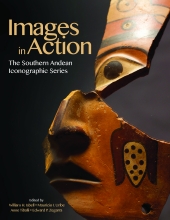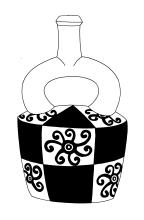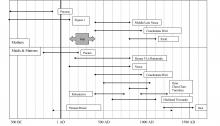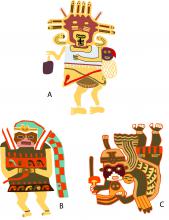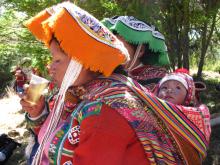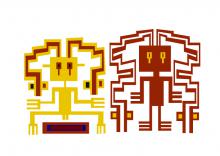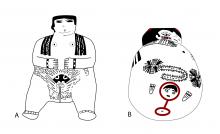Visual database
Moche I painted vessel showing figurative elements enclosed in individual square units with alternating colors (redrawn from the Museo Arqueológico Rafael Larco Hererra online catalog ML006877).
Vessels decorated with Wari "rombo" and "serpiente Chakipampa" from San José de Moro (from McClelland et al. 2007).
Chronological chart illustrating the relative time frame for materials discussed in the text.
Female "Occulate Being" with inverted "fetus" shown inside. The inverted position of the internal figure replicates the desired "presentation" for a baby about to be born. Repetition of the inverted form may have been a metaphor for successive generations, those yet to be born. Adapted and redrawn from Paul (1986).
Color block figures from Paracas textiles. (a) The larger figure with a smaller one carried on its back is outwardly of indeterminate sex but may represent a maternal image; (b) the weapon-bearing, loin cloth-wearing figure is usually referred to as a warrior and assumed therefore to be male; (c) the figure with a contorted upper body, severed head, and tumi knife has been referred to as a shaman, priest, or "sacrificer" and also assumed to be male. All figures adapted and redrawn from photographs. (a) and (b) from Lumbreras, Lavalle, and Lang (1979a); (c) from British Museum registry 1954,05.563, colors approximate.
Women in the Andes traditionally carry their infants and very young children in a backpack made from a textile as illustrated by the case of this Peruvian woman from the Cusco region photographed in 2012. Photo courtesy of Rachael McKaig.
(a) See photo by J. Haeberli (Figure 6.25, this volume).
(b) Images from the same textile fragment redrawn to demonstrate the representation of female genitalia. Symmetry of second figure (on the illustration's left) is assumed, colors approximate.
Late Nasca figurines showing women in birthing positions with body paint or tattoos on their abdomens. (a) Seated figurine with small modeled breasts and a mythical "taster" motif on the lower abdomen with the tongue emphasizing the location of the vaginal slit (after Proulx 2006:Figure 5.146). (b) An effigy jar showing the emerging face of the baby being born (drawn from photograph by Proulx 2006:Plate 35, colors approximate).
Examples of designs painted on late Nasca figurines. These motifs appear on the abdomen and/or across the back or buttocks of nude Nasca female figurines shown in the process of giving birth. They may represent supernatural beings invoked to protect mothers from attack by supernatural forces during or after childbirth. Other examples of these markings can be seen in Figure 20.6. (a) Figure on the abdomen of a "birthing" jar, from Kroeber and Collier (1998:171, Figure 254). (b) Figure on the abdomen of a "birthing" jar from figurine 33-15-1, Museum für Völkerkunde, based on drawing by Clados (2003). (c) Pair of creatures on the buttocks of a "birthing" jar, based on a drawing by Lavalle (1986:137).
